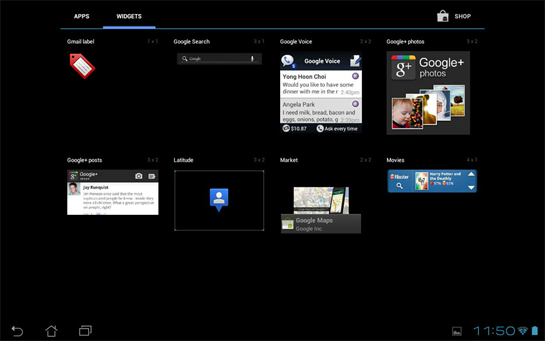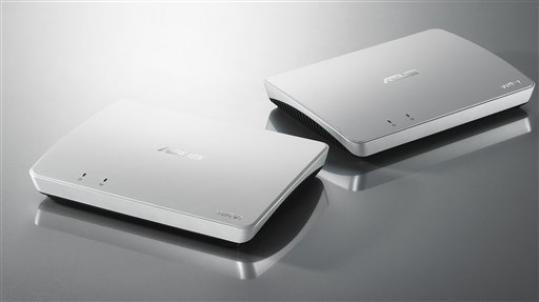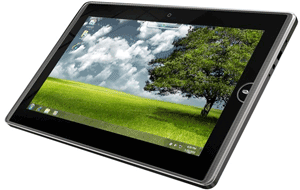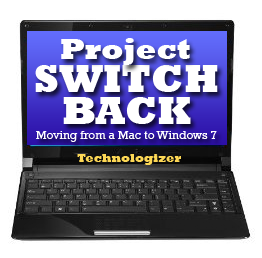
I’m still hoping that Android 4.0 Ice Cream Sandwich will help make Android tablets interesting to consumers in a way that Honeycomb-based Android tablets have not been. I haven’t tried one for myself yet. But JR Raphael of Computerworld has an Asus Transformer Prime with ICS–and he’s put together a nice walkthrough of the interface.
Tag Archives | ASUS
Mossberg Reviews Asus’s Convertible Tablet
 Over at All Things D, Walt Mossberg has reviewed Asus’s Transformer Prime, an Android Honeycomb tablet that has an optional, attachable keyboard. He likes it, sort of–although he likes the iPad better, and has multiple reservations.As someone who likes to use an iPad as a PC, I’m intrigued by Asus’s convertible design. It’s designed for folks like me who like tablets but also like clicky QWERTY keyboards. But I’m also worried about Walt’s battery tests, which showed the Prime running for a little under seven hours on a charge, vs. a little over ten hours for the iPad. My single favorite thing about the iPad isn’t the size or the weight or the apps–it’s that Apple claims ten hours of battery life, and–in my experience–delivers it.
Over at All Things D, Walt Mossberg has reviewed Asus’s Transformer Prime, an Android Honeycomb tablet that has an optional, attachable keyboard. He likes it, sort of–although he likes the iPad better, and has multiple reservations.As someone who likes to use an iPad as a PC, I’m intrigued by Asus’s convertible design. It’s designed for folks like me who like tablets but also like clicky QWERTY keyboards. But I’m also worried about Walt’s battery tests, which showed the Prime running for a little under seven hours on a charge, vs. a little over ten hours for the iPad. My single favorite thing about the iPad isn’t the size or the weight or the apps–it’s that Apple claims ten hours of battery life, and–in my experience–delivers it.
Continue Reading →
No comments
The Cost of Chrome OS: How About $250 or Less?
 When I wrote about Google’s experimental CR-48 Chrome OS notebook last December, I guessed that it might cost about $449 if it were a commercial product. That seemed high for a device that was entirely dedicated to accessing the Web (and nearly useless when you couldn’t get online). And a bunch of people told me my guestimate was too high.
When I wrote about Google’s experimental CR-48 Chrome OS notebook last December, I guessed that it might cost about $449 if it were a commercial product. That seemed high for a device that was entirely dedicated to accessing the Web (and nearly useless when you couldn’t get online). And a bunch of people told me my guestimate was too high.
Months later, nobody has announced any detail on the Chrome OS machines which will supposedly be shipping in just a few months. But there are rumors–courtesy of rumor kingpin Digitimes–that Asus has plans to release a netbook for $200-$250 in June. One that might conceivably run Chrome OS. (I say “might conceivably” because Digitimes’ sources say that Asus “should” use either Chrome OS or Android on the machine–which is a whole lot vaguer than saying that Asus will use either one of those operating systems.)
Could Asus sell a decent Chrome OS laptop with an 12.1″ screen and built-in wireless broadband for $250 or less? That sounds aggressive to me. But if they can manage it, the deal sounds a whole lot more appealing than the $449 Chromebook I envisioned. And if they can sell a clamshell device at that pricetag, couldn’t they whack off the keyboard, add an on-screen one, and have a plausible low-end tablet?
5 comments
PrimeSense and Asus Bringing Kinect Tech to PCs
 It was just over a year ago when PrimeSense showed me (and Harry, separately) a demo of the motion-sensing camera technology that helps power Microsoft’s Kinect game controller. Now, PrimeSense is spreading out and partnering with Asus for gesture control on PCs.
It was just over a year ago when PrimeSense showed me (and Harry, separately) a demo of the motion-sensing camera technology that helps power Microsoft’s Kinect game controller. Now, PrimeSense is spreading out and partnering with Asus for gesture control on PCs.
The WAVI Xtion is a motion sensor for browsing multimedia and Internet content, using PrimeSense’s camera and infrared sensor tech to track users in 3D space. It’s meant for home theater PCs and will be commercially available in the second quarter, price unspecified.
More exciting, I think, is Xtion PRO, a tool for third-party developers to create their own gesture-based applications and software. Asus plans to host an online store for developers to hawk their motion-sensing apps, presumably to consumers who buy the WAVI Xtion sensor. The PRO development tools are coming in February.
It all sounds kind of lofty, given that Asus is primarily a hardware company, but if all goes to plan on the software front, Asus could be the the first company to create a market for the creativity of Kinect hackers. We’ve seen some pretty impressive tech demos from hobbyists, so I can only imagine what would come from financial incentives in the form of an app marketplace.
PrimeSense will have the whole setup on display at the Consumer Electronics Show this week. I plan to check it out.
No comments
Acer's Dual-Screen Notebook vs. Asus's Potent Thin-and-Light: Which Do You Like?
 Now that we’ve identified our semi-finalists for the Last Gadget Standing event at next month’s Consumer Electronics Show, we’d like your input on some of the contenders. There aren’t any direct competitors among them–many of the products, in fact, are pretty darn unique.
Now that we’ve identified our semi-finalists for the Last Gadget Standing event at next month’s Consumer Electronics Show, we’d like your input on some of the contenders. There aren’t any direct competitors among them–many of the products, in fact, are pretty darn unique.
We do, however, have two Windows portables. There’s Acer’s Iconia, which ditches a physical keyboard in favor of a second screen that can display information or serve as a ten-finger multitouch keyboard. And there’s Asus’s U36Jc, which looks far more conventional than the Iconia but packs components–an Intel i5 CPU and discrete Nvidia graphics–which you might not expect to find in a thin-and-light laptop with a 13″ display.
Two interesting-but-very-different machines. Your take, please:
2 comments
Deceptively Thin, Surprisingly Fast
 Last Gadget Standing Nominee: Asus U36Jc-A1
Last Gadget Standing Nominee: Asus U36Jc-A1
Price: $999
 The computing world is awash in powerful laptops. There are also more and more thin-and-light notebooks with 13″ screens. But 13″ thin-and-lights that are truly powerful? They’re still a rare breed. That’s what makes the Asus U36Jc-A1 intriguing: It looks like a typical 13-incher that emphasizes portability over potency, but it packs a standard-voltage Intel Core i5 CPU and Nvidia G310M discrete graphics. It also has Nvidia’s Optimus technology, which lets the system switch between the G310M and integrated graphics on the fly for better battery life–Asus says it can run up to nine hours on a charge.
The computing world is awash in powerful laptops. There are also more and more thin-and-light notebooks with 13″ screens. But 13″ thin-and-lights that are truly powerful? They’re still a rare breed. That’s what makes the Asus U36Jc-A1 intriguing: It looks like a typical 13-incher that emphasizes portability over potency, but it packs a standard-voltage Intel Core i5 CPU and Nvidia G310M discrete graphics. It also has Nvidia’s Optimus technology, which lets the system switch between the G310M and integrated graphics on the fly for better battery life–Asus says it can run up to nine hours on a charge.
The U36Jc-A1 has an aluminum-magnesium alloy shell, is .76″ thick, and weighs 3.4 pounds. Asus says it’ll go on sale on January 17th.
2 comments
Asus Pronunciation Demystified
At last, Asus has clarified how to pronounce its name (“Eh-Seuss”). Still no hope for all those unfortunately-named products.
2 comments
In Search of Microsoft's Tablet Strategy
 It’s Memorial Day in the U.S., but in Taipei, it’s time for Computex–the show that serves as an excellent freeze-frame of what the PC industry is excited about at the moment. Judging from the news so far, what it’s excited about is the iPad.
It’s Memorial Day in the U.S., but in Taipei, it’s time for Computex–the show that serves as an excellent freeze-frame of what the PC industry is excited about at the moment. Judging from the news so far, what it’s excited about is the iPad.
As Engadget is reporting, Asus is showing off something called the Eee Pad at the show–a vaguely iPad-esque looking device that runs Windows 7, packs an Intel ultra-low voltage CPU, and (like the iPad) claims ten hours of battery life on a charge. It’s safe to say that Asus still has heavy lifting to do to make the Eee Pad a reality: It isn’t planning to ship it until next year. By then, it’ll face competition from other Windows 7 tablets, such as this Computex debutante from MSI, not to mention Android tablets (MSI is showing one of those, too)
9 comments
Asus’s E-Reader Breakthrough?
A “6in, high-brightness, OLED colour screen that should run for a whopping 122 hours on one battery charge“? That’s either one of the biggest breakthroughs in display technology in eons, or a misunderstanding, or partial information that doesn’t mention some gigantic gotcha. I hope it’s the first of these possibilities, but I’m not placing any bets…
No comments
Project Switchback: Moving from a Mac to Windows 7
 Back in 2004, I was shopping for a new laptop at CompUSA. I took a wrong turn into the store’s tiny Apple section and had an epiphany: Why not buy a Mac? (I’d been a Mac user in the 1980s, and still used them on the job to do page layouts, but every computer I’d bought since 1992 had run Windows.) If nothing else, I figured it would make me a smarter computer journalist, and I couldn’t think of any showstopping arguments against owning a Mac…even though I was the editor of PC World.
Back in 2004, I was shopping for a new laptop at CompUSA. I took a wrong turn into the store’s tiny Apple section and had an epiphany: Why not buy a Mac? (I’d been a Mac user in the 1980s, and still used them on the job to do page layouts, but every computer I’d bought since 1992 had run Windows.) If nothing else, I figured it would make me a smarter computer journalist, and I couldn’t think of any showstopping arguments against owning a Mac…even though I was the editor of PC World.
I ended up buying a 12-inch PowerBook. I’ve purchased and used both Macs and Windows machines in the years since, but have unquestionably logged more hours on Macs than on Windows PCs over the past two or three years.
That’s about to change, at least for a little while. Now that Windows 7 is the current version of the operating system, I’m not only going to use it–which I’ve been doing with various versions for a year–but to run it as my primary OS. What better way to come to some real-world, up-to-the-moment conclusions about how Windows and Apple’s OS compare?
